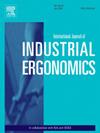在模拟订单挑选任务中探索背景音乐对视觉搜索的影响:表现、意识和主观状态
IF 2.5
2区 工程技术
Q2 ENGINEERING, INDUSTRIAL
International Journal of Industrial Ergonomics
Pub Date : 2025-01-01
DOI:10.1016/j.ergon.2024.103693
引用次数: 0
摘要
音乐对完成简单单调任务的好处已经得到了广泛的研究。然而,在复杂和嘈杂的环境中,音乐的潜在优势如何在职业环境中实现,这在很大程度上仍未得到探索。对30名参与者进行了一项实验室实验,以评估不同信噪比的音乐(古典、爵士、流行、EDM、摇滚)与仓库声音(信噪比为+5、0、- 5、- 10)如何影响模拟拣货任务中的视觉搜索。结果表明,相对于仓库的声音,音乐对参与者的表现既没有负面影响,也没有正面影响,但声乐会增加唤醒,显著改善效价和凹槽,但会降低感知卡车哔哔声的能力。同时,在音乐类型中,音乐强度的增加会导致对卡车哔哔声的识别能力下降,但对搜索性能、影响和凹槽的影响不显著。为了在工作场所的舒适、生产力、质量和安全之间取得最佳平衡,任何类型的音乐都可以使用,最好是轻快的节奏、人声,以及音乐与背景(即职业)噪音之间的水平差最高为5 dB (a)。该研究拓宽了对工作音乐的科学理解,并为如何在复杂嘈杂的声音环境中轻松单调的任务中执行音乐提供了实用指导。本文章由计算机程序翻译,如有差异,请以英文原文为准。
Exploring the impacts of background music on visual search in a simulated order-picking task: Performance, awareness, and subjective state
The benefits of music on the performance of easy and monotonous tasks have been widely investigated. However, how the potential advantages of music could be realized in an occupational context within a complex and noisy environment remains largely unexplored. A laboratory experiment with 30 participants was performed to assess how music (classical, jazz, pop, EDM, rock) of varying signal-to-noise ratios with warehouse sound (SNR +5, 0, −5, −10) impacts visual search in a simulated order-picking task. Results showed that relative to the warehouse sound alone, music led to neither negative nor positive effects on the participants’ performance, yet elicited increased arousal with vocal music, significantly improved valence and groove, but reduced awareness represented by the ability to detect truck beeps. Meanwhile, within genre, increasing music intensity caused diminished ability to detect truck beeps, but did not significantly influence search performance, affect and groove. To gain optimal tradeoff among comfort, productivity, quality and safety in the workplace, music of any genre could be used, preferably with upbeat tempo, vocals, and with a level difference between music and background (i.e, occupational) noise of maximally 5 dB (A). The study broadens the scientific understanding of music-at-work, and imparts practical guidance on how music may be implemented in easy and monotonous tasks under complex and noisy sound environments.
求助全文
通过发布文献求助,成功后即可免费获取论文全文。
去求助
来源期刊
CiteScore
6.40
自引率
12.90%
发文量
110
审稿时长
56 days
期刊介绍:
The journal publishes original contributions that add to our understanding of the role of humans in today systems and the interactions thereof with various system components. The journal typically covers the following areas: industrial and occupational ergonomics, design of systems, tools and equipment, human performance measurement and modeling, human productivity, humans in technologically complex systems, and safety. The focus of the articles includes basic theoretical advances, applications, case studies, new methodologies and procedures; and empirical studies.

 求助内容:
求助内容: 应助结果提醒方式:
应助结果提醒方式:


